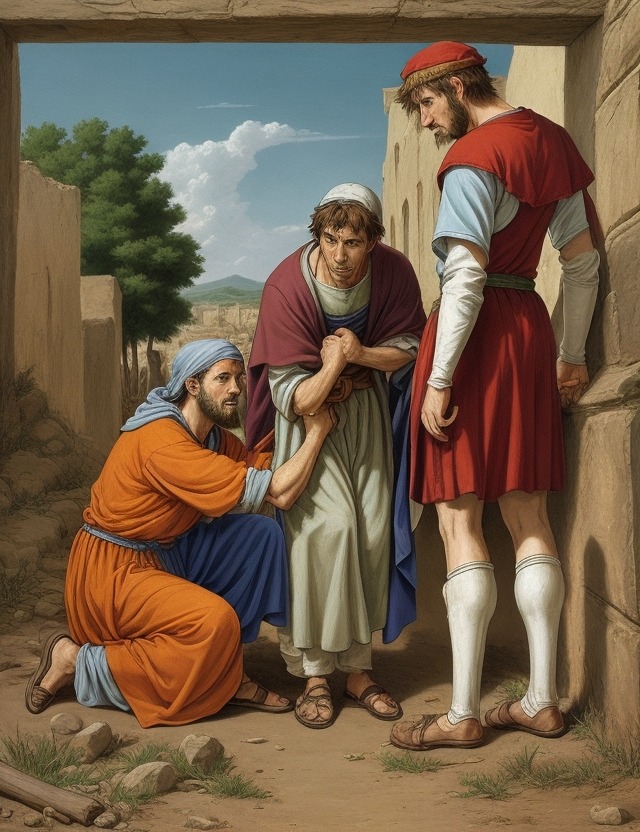Deeply woven within the tapestry of human existence are biblical stories that resonate across time, capturing our imagination, emotions, and ultimately leaving indelible imprints on our souls. Such is the case with the captivating parable, “Good Samaritan,” penned by an author whose craftsmanship is celebrated in literary circles worldwide.
Join us as we expose the hidden depths of “Good Samaritan” and the profound questions it poses, shining a light on the shadows of our own humanity, for all is not what it seems…
Stay tuned for a comprehensive exploration of this remarkable masterpiece, as we dive into the mesmerizing world of “Good Samaritan,” a story that will challenge your beliefs, provoke your thoughts, and leave an indelible imprint long after the final page has been turned.
The Parable of Good Samaritan Summary and Short Story
The Parable of a Good Samaritan
Story of The Good Samaritan Summary. The Parable of the Good Samaritan is a poignant and timeless story recounted by Jesus in the New Testament of the Bible, specifically in the Gospel of Luke (Luke 10:25-37). The parable of the Good Samaritan in Luke 10 teaches a powerful lesson on compassion, love, and the universal nature of humanity.
The parable unfolds in response to a question posed to Jesus by a lawyer, who seeks to test him and justify himself. The lawyer asks, “Who is my neighbor?” In response, Jesus shares the story of a man traveling from Jerusalem to Jericho who falls victim to robbers. They strip him of his clothes, beat him, and leave him half-dead by the side of the road.
A priest and a Levite, both esteemed figures in Jewish society, pass by the wounded man without offering assistance. Despite their religious positions, they choose to avoid the injured traveler, possibly due to concerns about ritual purity or personal safety. Their actions highlight a lack of compassion and a failure to fulfill the commandments of love.
Enter the unexpected hero of the story: a Samaritan. Samaritans and Jews had a deep-seated animosity based on historical, religious, and cultural differences. Yet, when the Samaritan sees the injured man, he is moved with compassion. He binds the man’s wounds, pours oil and wine on them, places him on his own animal, and takes him to an inn.
At the inn, the Samaritan continues to care for the injured man. He spends the night tending to his needs and provides the innkeeper with money, instructing him to take care of the man and promising to return and cover any additional expenses.
Through this parable, Jesus challenges the narrow definition of “neighbor” that the lawyer seeks to establish. The lesson is clear: a neighbor is not confined to those who share the same religious, ethnic, or social background. Instead, a neighbor is anyone who shows mercy and compassion, regardless of societal expectations or preconceived notions.
The Parable of the Good Samaritan emphasizes the importance of compassion in living a life aligned with the teachings of Jesus. It rebukes self-righteousness, challenges prejudices, and encourages a broader understanding of love and mercy. The Samaritan’s actions underscore the call to love one’s neighbor as oneself, transcending conventional boundaries and exemplifying the universal principles of kindness and empathy.
This parable has resonated through the centuries, inspiring countless individuals and movements to extend a helping hand to those in need. It serves as a timeless reminder that genuine love and compassion know no borders, and true kindness seeks to uplift and heal, even in the face of historical animosities and societal divisions.
Good Samaritan: Key Themes
The theme of the Good Samaritan parable, as recounted in the Gospel of Luke in the New Testament of the Bible, revolves around the principles of compassion, mercy, and the expansive definition of neighborly love. Several key themes emerge from this powerful and instructive story:
- Universal Compassion: The parable challenges individuals to extend compassion universally. The Samaritan, despite cultural and historical animosities, demonstrates that compassion knows no boundaries. It encourages believers to look beyond preconceived notions and stereotypes, urging them to show empathy to all, regardless of differences in ethnicity, religion, or social status.
- Neighborly Love: The parable underscores the commandment to “love your neighbor as yourself.” It expands the definition of “neighbor” beyond geographical or cultural boundaries. By illustrating the Samaritan’s actions, the parable emphasizes that true love and compassion are not restricted to those who are similar or familiar but extend to all who are in need.
- Critique of Religious Hypocrisy: The failure of the priest and the Levite to assist the wounded man highlights a critique of religious hypocrisy. Despite their religious positions, they do not embody the principles of compassion and mercy that their faith advocates. The Samaritan, considered an outsider in terms of religious orthodoxy, becomes the exemplar of righteousness through his actions.
- Actions Speak Louder Than Words: The parable emphasizes the significance of concrete actions over mere words or professions of faith. The Samaritan’s deeds — binding wounds, providing care, and offering financial support — are tangible expressions of love and mercy. It suggests that true faith is demonstrated through compassionate actions toward those in need.
- Social Justice: The parable addresses social justice by highlighting the responsibility individuals have to care for the vulnerable and marginalized. The wounded man represents those who, due to circumstances beyond their control, find themselves in dire straits. The call to be a Good Samaritan extends to addressing societal inequalities and advocating for justice.
- Personal Sacrifice: The Samaritan’s willingness to expend time, effort, and resources for the well-being of a stranger illustrates the theme of personal sacrifice. It challenges believers to go beyond their comfort zones, inconvenience themselves, and make personal sacrifices in the service of others.
- Eternal Life and Salvation: In response to the lawyer’s question about eternal life, Jesus instructs him to “go and do likewise” as the Samaritan did. This implies that embodying the principles of the Good Samaritan is linked to one’s understanding of eternal life and salvation. Acts of compassion and love are seen as integral to the Christian journey.
Overall, the theme of the Good Samaritan parable resonates with the fundamental teachings of love, compassion, and service that are central to Christian ethics. It encourages believers to embody these principles in their interactions with others and to actively engage in acts of mercy, kindness, and social justice.
Good Samaritan: Characters
The Good Samaritan parable, as recounted in the Gospel of Luke in the New Testament of the Bible, features several characters, each playing a significant role in conveying the story’s moral and theological messages. The key characters include:
- The Lawyer: The story begins with a lawyer posing a question to Jesus: “Who is my neighbor?” This character represents the legal and religious authorities of the time. The question is an attempt to test Jesus and perhaps justify the lawyer’s actions. However, this character sets the stage for Jesus to share the parable.
- The Traveler: The victim of the robbery and violence on the road from Jerusalem to Jericho is a generic traveler. The parable does not provide specific details about his identity, emphasizing the universality of the human condition. The traveler becomes a symbol of vulnerability and helplessness.
- The Priest: The priest is the first passerby after the traveler has been attacked. Despite his religious position and presumably compassionate role, the priest avoids helping the wounded man. His actions highlight the failure of religious figures to embody the principles of mercy and compassion.
- The Levite: Similar to the priest, the Levite is another figure of religious authority who passes by without offering assistance to the injured traveler. The inclusion of both a priest and a Levite emphasizes the failure of the religious establishment to fulfill the commandments of love and compassion.
- The Samaritan: The central and unexpected hero of the story, the Samaritan, challenges societal prejudices and religious biases. Samaritans and Jews had a history of animosity, making the Samaritan’s compassionate actions particularly remarkable. His willingness to help, provide care, and sacrifice his time and resources exemplifies the qualities of a good neighbor.
- The Innkeeper: Toward the end of the parable, the Samaritan brings the injured traveler to an inn. The innkeeper becomes a minor character who provides a place for the wounded man to recover. The innkeeper’s role emphasizes the importance of community involvement and assistance in caring for those in need.
These characters collectively contribute to the parable’s overarching message about compassion, love, and the universal nature of neighborly care. The contrast between the actions of the priest and the Levite and the unexpected goodness of the Samaritan serves as a powerful illustration of Jesus’s teachings on the true meaning of love and mercy.
Good Samaritan: Symbols
The Good Samaritan parable contains several symbols that convey deeper meanings and contribute to the overall moral and theological themes of the story. Some key symbols include:
- The Road from Jerusalem to Jericho:
- Symbolism: The dangerous and winding road serves as a symbol of life’s journey, with its challenges, uncertainties, and the potential for unexpected hardships. The choice of this particular road also reflects the spiritual and moral dimensions of the traveler’s predicament.
- The Robbers:
- Symbolism: The robbers represent the forces of evil and violence in the world. Their actions lead to the suffering of the traveler and set the stage for the moral choices made by subsequent characters in the parable.
- The Priest and the Levite:
- Symbolism: The priest and the Levite, both figures of religious authority, symbolize the failure of organized religion to demonstrate compassion and fulfill the commandments of love. Their actions underscore the contrast between religious ritualism and the true spirit of mercy.
- The Samaritan:
- Symbolism: The Samaritan represents unexpected goodness and compassion. As a member of a group historically at odds with the Jews, the Samaritan challenges societal prejudices and religious biases. His actions symbolize the inclusive nature of love and the breaking down of cultural and religious barriers.
- Oil and Wine:
- Symbolism: The Samaritan uses oil and wine to cleanse and soothe the wounds of the injured traveler. These elements symbolize healing and restoration. Oil, often associated with anointing in biblical contexts, can represent spiritual healing, while wine may symbolize the Eucharist or the blood of Christ.
- The Beast of Burden:
- Symbolism: The Samaritan places the wounded man on his own animal, emphasizing the sacrifice and selflessness inherent in his actions. The beast of burden becomes a symbol of the Samaritan’s willingness to go out of his way, inconveniencing himself for the sake of another.
- The Inn:
- Symbolism: The inn represents a place of refuge and recovery. The Samaritan takes the injured traveler to the inn, symbolizing the importance of community and the role of institutions in providing care and support for those in need.
- The Two Denarii:
- Symbolism: The Samaritan gives the innkeeper two denarii, symbolizing his commitment to cover the cost of the traveler’s care. The generosity of the Samaritan reflects the sacrificial nature of true compassion.
- The Innkeeper:
- Symbolism: The innkeeper symbolizes the broader community and its role in caring for those in need. His willingness to take in the injured traveler aligns with the theme of communal responsibility for the well-being of others.
The use of these symbols adds depth to the parable, allowing for various layers of interpretation and reinforcing the overarching themes of compassion, love, and the universal nature of neighborly care.
Good Samaritan: Culture Impact
The Good Samaritan parable has had a profound and enduring impact on various aspects of culture, influencing literature, art, ethics, and discussions on compassion and altruism. Here are some ways in which the story has left its mark:
- Literature:
- The term “Good Samaritan” has become a part of the English language, often used to describe a person who selflessly helps others, especially strangers, in times of need. This linguistic adoption reflects the parable’s influence on everyday communication.
- Art and Visual Representations:
- Artists throughout history have depicted scenes from the Good Samaritan parable in paintings, sculptures, and other visual mediums. These artworks often emphasize the compassion and selflessness of the Samaritan, reinforcing the narrative’s moral message.
- Religious Teachings and Sermons:
- The Good Samaritan is frequently cited in religious teachings and sermons across various denominations of Christianity. It serves as a foundational text for discussions on love, compassion, and the ethical responsibilities of individuals towards others.
- Legal and Ethical Discourse:
- The concept of the Good Samaritan has influenced legal and ethical discussions, particularly in the context of duty to rescue laws. These laws, which vary by jurisdiction, often consider whether individuals have an obligation to provide assistance to those in peril.
- Humanitarian Organizations:
- The parable has inspired the missions and values of numerous humanitarian and charitable organizations. Many organizations use the story as a guiding principle, emphasizing the importance of compassion and active engagement in helping those in need.
- Secular Morality and Philosophy:
- Beyond its religious context, the Good Samaritan parable has become a symbol of moral conduct and altruism in secular ethics and philosophy. It is often cited in discussions about the moral obligations of individuals within society.
- Popular Culture:
- References to the Good Samaritan frequently appear in popular culture, including books, movies, and television shows. These references may use the story to convey moral lessons, explore themes of empathy, or highlight acts of kindness.
- Social Psychology:
- The Good Samaritan parable has been studied in the field of social psychology, particularly in experiments exploring factors that influence helping behavior. Research has delved into the impact of situational factors on individuals’ willingness to assist others.
- Interfaith Dialogue:
- The parable is often invoked in interfaith dialogue as a shared moral narrative that transcends religious boundaries. It serves as a common ground for discussions on compassion, kindness, and shared human values.
The enduring impact of the Good Samaritan parable across cultural, religious, and ethical domains underscores its universal appeal and timeless relevance in shaping attitudes toward compassion and altruism.
Good Samaritan Questions and Answers
- Who Was the Good Samaritan?
- This question often arises as people seek to understand the identity and background of the Samaritan in the parable. The answer highlights the unexpected goodness of a Samaritan, a member of a group historically at odds with Jews, who showed compassion to a wounded traveler.
- What Is the Moral Lesson of the Good Samaritan Parable?
- Many people inquire about the primary moral lesson or message conveyed by the parable. The answer emphasizes the universal call to compassion, love, and the broad definition of “neighbor” that transcends cultural, religious, and societal boundaries.
- Why Did the Priest and the Levite Pass By the Injured Traveler?
- This question explores the motivations behind the actions of the priest and the Levite, both religious figures who chose not to help the injured traveler. Responses often highlight themes of religious hypocrisy, ritual purity concerns, or a failure to embody the principles of mercy.
- How Does the Good Samaritan Parable Relate to Modern Ethics?
- Inquiries about the parable’s relevance in contemporary ethical discussions are common. Answers may touch on the parable’s impact on discussions about altruism, moral responsibility, and the duty to help those in need in today’s society.
- What Does “Love Your Neighbor as Yourself” Mean in the Good Samaritan Story?
- This question delves into the broader context of the parable within biblical teachings. Responses emphasize the connection between the Good Samaritan narrative and the commandment to “love your neighbor as yourself,” stressing the inclusive and selfless nature of true love.










